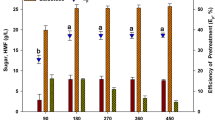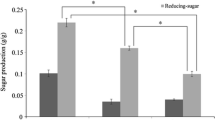Abstract
Acetone, butanol, and ethanol (ABE) were produced following the separate hydrolysis and fermentation (SHF) method using polysaccharides from the green macroalgae Enteromorpha intestinalis as biomass. We focused on the optimization of enzymatic saccharification as pretreatments for the fermentation of E. intestinalis. Pretreatment was carried out with 10% (w/v) seaweed slurry and 270-mM H2SO4 at 121 °C for 60 min. Monosaccharides (mainly glucose) were obtained from enzymatic hydrolysis with a 16-U/mL mixture of Celluclast 1.5 L and Viscozyme L at 45 °C for 36 h. ABE fermentation with 10% (w/v) E. intestinalis hydrolysate was performed using the anaerobic bacteria Clostridium acetobutylicum with either uncontrolled pH, pH controlled at 6.0, or pH controlled initially at 6.0 and then 4.5 after 4 days, which produced ABE contents of 5.6 g/L with an ABE yield (YABE) of 0.24 g/g, 4.8 g/L with an YABE of 0.2 g/g, and 8.5 g/L with an YABE of 0.36 g/g, respectively.





Similar content being viewed by others
References
Karimi K, Tabatabaei M, Horváth IS, Kumar R (2015) Recent trends in acetone, butanol, and ethanol (ABE) production. Biofuel Res J 8:301–308
Huang H, Songh V, Qureshi N (2015) Butanol production from food waste: a novel process for producing sustainable energy and reducing environmental pollution. Biotechnol Biofuels 8:147
Ndaba B, Chiyanzu I, Marx S (2015) n-Butanol derived from biochemical and chemical routes: A review. Biotechnol Rep (Amst) 8:1–9
Madihah MS, Ariff AB, Sahaid KM, Suraini AA, Karim MIA (2011) Direct fermentation of gelatinized sago starch to acetone-butanol-ethanol by Clostridium acetobutylicum. World J Microbiol Biotechnol 17:567–576
Kalidas S, Gopinadhan P, Anthony P, Robert EL (2005) Food Biotechnology, 2nd edn. Taylor & Francis, Boca Raton
Ezeji TC, Qureshi N, Blaschek HP (2007) Production of acetone butanol (AB) from liquefied corn starch, a commercial substrate, using Clostridium beijerinckii coupled with product recovery by gas stripping. J Ind Microbiol Biotechnol 34:771–777
Qureshi N, Li X-L, Hughes S, Saha BC, Cotta MA (2006) Butanol Production from corn fiber xylan using Clostridium acetobutylicum. Biotechnol Prog 22:673–680
Qureshi N, Ezeji TC (2008) Butanol, “a superior biofuel” production from agricultural residues (renewable biomass): recent progress in technology. Biofuels Bioprod Biorefining 2:319–330
Qureshi N, Saha BC, Cotta MA (2007) Butanol production from wheat straw hydrolysate using Clostridium beijerinckii. Bioprocess Biosyst Eng 30:419–427
Jurgens G, Survase S, Berezina O, Sklavounos E, Linnekoski J, Kurkijärvi A, Väkevä M, van Heiningen A, Granström T (2012) Butanol production from lignocellulosics. Biotechnol Lett 34:1415–1434
Cai D, Zhang T, Zheng J, Chang Z, Wang Z, Qin PY, Tan TW (2013) Biobutanol from sweet sorghum bagasse hydrolysate by a hybrid pervaporation process. Bioresour Technol 145:97–102
Ezeji T, Qureshi N, Blaschek HP (2007) Butanol production from agricultural residues: Impact of degradation products on Clostridium beijerinckii growth and butanol fermentation. Biotechnol Bioeng 97:1460–1469
Li K, Liu S, Liu X (2014) An overview of algae bioethanol production. Int J Energy Res 38:965–977
van der Wal H, Sperber BLHM, Houweling-Tan B, Bakker RRC, Brandenburg W, López-Contreras AM (2013) Production of acetone, butanol, and ethanol from biomass of the green seaweed Ulva lactuca. Bioresour Technol 128:431–437
Feng D, Liu H, Li F, Jiang P, Qin S (2011) Optimization of dilute acid hydrolysis of Enteromorpha. Chinese J Oceanol Limnol 29:1243–1248
Mo X, Pei J, Guo Y, Lin L, Peng L, Kou C, Fan D, Pang H (2015) Genome Sequence of Clostridium acetobutylicum GXAS18-1, a Novel Biobutanol Production Strain. Genome Announc 3:e00033–e00015
Bahl H, Andersch W, Braun K, Gottschalk G (1982) Effect of pH and butyrate concentration on the production of acetone and butanol by Clostridium acetobutylicum grown in continuous culture. Eur J Appl Microbiol Biotechnol 14:17–20
Millat T, Janssen H, Bahl H, Fischer R, Wolkenhauer O (2013) Integrative modelling of pH-dependent enzyme activity and transcriptomic regulation of the acetone-butanol-ethanol fermentation of Clostridium acetobutylicum in continuous culture. Microb Biotechnol 6:526–539
AOAC(Association of Official Analysis Chemists) (1995) Official methods of analysis of the association of official analytical chemists, 16th edn. Association of Official Analysis Chemists, Arlington
Marinho-Soriano E, Fonseca PC, Carneiro MAA, Moreira WSC (2006) Seasonal variation in the chemical composition of two tropical seaweeds. Bioresour Technol 97:2402–2406
Silva DJ (1990) Análise de alimentos: Métodos químicos e biológicos.Viçosa, Brazil
James CS (1996) Analytical chemistry of foods. Chapman and Hall, New York
Mandels M, Andreotti R, Roche C (1976) Measurement of saccharifying cellulase. Biotechnol Bioeng Symp 6:21–33
Kubicek CP (1982) beta-Glucosidase excretion by Trichoderma pseudokoningii: correlation with cell wall bound beta-1.3-glucanase activities. Arch Microbiol 132:349–354
Kheyrandish M, Asadollahi MA, Jeihanipour A, Doostmohammadi M, Rismani-Yazdi H, Karimi K (2015) Direct production of acetone–butanol–ethanol from waste starch by free and immobilized Clostridium acetobutylicum. Fuel 142:129–133
Redding AP, Wang Z, Keshwani DR, Cheng JJ (2011) High temperature dilute acid pretreatment of coastal Bermuda grass for enzymatic hydrolysis. Bioresour Technol 102:1415–1424
Ahn DJ, Kim SK, Yun HS (2012) Optimization of pretreatment and saccharification for the production of bioethanol from water hyacinth by Saccharomyces cerevisiae. Bioprocess Biosyst Eng 35:35–41
Millat T, Janssen H, Thorn GJ, King JR, Bahl H, Fischer RJ, Wolkenhauer O (2013) A shift in the dominant phenotype governs the pH-induced metabolic switch of Clostridium acetobutylicumin phosphate-limited continuous cultures. Appl Microbiol Biotechnol 97:6451–6466
Jones DT, Woods DR (1986) Acetone-butanol fermentation revisited. Microbiol Rev 50:484–524
Li T, Yan Y, He J (2014) Reducing cofactors contribute to the increase of butanol production by a wild-type Clostridium sp. strain BOH3. Bioresour Technol 155:220–228
Ra CH, Jeong G-T, Kim S-K (2017) Hyper-thermal acid hydrolysis and adsorption treatment of red seaweed, Gelidium amansii for butyric acid production with pH control. Bioprocess Biosyst Eng 40:403–411
Yang X, Tu M, Xie R, Adhikari S, Tong Z (2013) A comparison of three pH control methods for revealing effects of undissociated butyric acid on specific butanol production rate in batch fermentation of Clostridium acetobutylicum. AMB Express 3:3
Zhang J, Wang M, Gao M, Fang X, Yano S, Qin S, Xia R (2013) Efficient acetone–butanol–ethanol production from corncob with a new pretreatment technology—wet disk milling. BioEnergy Res 6:35–43
Ren C, Gu Y, Hu S, Wu Y, Wang P, Yang Y, Yang C, Yang S, Jiang W (2010) Identification and inactivation of pleiotropic regulator CcpA to eliminate glucose repression of xylose utilization in Clostridium acetobutylicum. Metab Eng 12:446–454
Geng Q, Park C-H (1993) Controlled-pH batch butanol-acetone fermentation by low acid producing Clostridium acetobutylicum B18. Biotechnol Lett 15:421–426
Tashiro Y, Shinto H, Hayashi M, Baba S, Kobayashi G, Sonomoto K (2007) Novel high-efficient butanol production from butyrate by non-growing Clostridium saccharoperbutylacetonicum N1-4 (ATCC 13564) with methyl viologen. J Biosci Bioeng 104:238–240
Yang M, Kuittinen S, Zhang J, Vepsäläinen J, Keinänen M, Pappinen A (2015) Co-fermentation of hemicellulose and starch from barley straw and grain for efficient pentoses utilization in acetone–butanol–ethanol production. Bioresour Technol 179:128–135
Qureshi N, Saha BC, Dien B, Hector RE, Cotta MA (2010) Production of butanol (a biofuel) from agricultural residues: Part I – Use of barley straw hydrolysate. Biomass bioenergy 34:559–565
Linggang S, Yee Phang L, Wasoh H, Abd-Aziz S (2013) Acetone–Butanol–Ethanol Production by Clostridium acetobutylicum ATCC 824 using sago pith residues hydrolysate. BioEnergy Res 6:321–328
Acknowledgements
This research was supported by Basic Science Research Program through the National Research Foundation of Korea, funded by the Ministry of Education (2016R1D1A1A09918683).
Author information
Authors and Affiliations
Corresponding author
Ethics declarations
Conflict of interest
The authors indicate no potential conflicts of interest.
Rights and permissions
About this article
Cite this article
Nguyen, T.H., Sunwoo, I.Y., Ra, C.H. et al. Acetone, butanol, and ethanol production from the green seaweed Enteromorpha intestinalis via the separate hydrolysis and fermentation. Bioprocess Biosyst Eng 42, 415–424 (2019). https://doi.org/10.1007/s00449-018-2045-6
Received:
Accepted:
Published:
Issue Date:
DOI: https://doi.org/10.1007/s00449-018-2045-6




